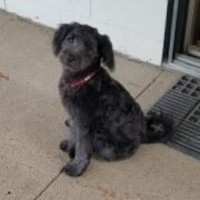Appearance of the English Coonoodle
|
| English Coonoodles generally resemble a Poodle without a shaggy coat and with certain characteristics similar to those of a hunting dog. English Coonoodles are medium-sized dogs, averaging between 18 and 29.5 kilos in weight and 48 to 58.5 centimeters in height. They have a relatively square, gangly but athletic build. They are combinations of red, white, blue, brown, black and tan, spotted in some areas and ticked in others. However, depending on the color of the Poodle parent, the coat may also be influenced by silver, gray, cream and apricot. English Coonoodles have gentle, intelligent expressions, with low-set floppy ears, a long muzzle that ends in a black nose and round, usually brown eyes. They also have a tapered, medium-length tail and rounded paws with heavy pads for escapades in wet, wooded areas. |
Temperament of the English Coonoodle
|
| The devoted English Coonoodle can be both discreet and energetic, depending on the situation. These dogs are people-oriented and like to relax and snuggle with their owners. Despite their size, they are known to curl up with their humans like little lapdogs. They are also intelligent and respond well to obedience training, especially if trained early and systematically. At the same time, they are athletic dogs that require a great deal of exercise and mental stimulation. English Coonoodles that resemble their Poodle ancestors can be nervous and quite vocal, having inherited the barking and howling of both parent breeds. Given their hunting heritage, English Coonoodles tend to roam and hunt, so they need to be supervised when off-leash. In addition, they can be hesitant with strangers or aggressive towards small pets and children, so it's best to supervise your English Coonoodle when introducing it to new people and animals. |
Needs and activities of the English Coonoodle
|
| Because English Coonoodles come from two high-energy breeds, they require a fair amount of exercise and activity. English Coonoodles should have at least one moderate to long walk a day, combined with recreation with their owner or a walk in the dog park. English Coonoodles may even bathe on occasion. This breed has a very strong hunting instinct, so keep in mind that even a slight trigger will go off. As such, it's best to supervise English Coonoodles in off-leash situations. Having access to an English Coonoodle sporting outlet will help satisfy this impulse, as well as provide an excellent exercise routine. Despite their energy, these dogs are not afraid of small living spaces and can adapt to apartment life if necessary, especially if they get a good dose of daily exercise. |
Maintenance of the English Coonoodle
|
| English Coonoodles are moderate excretors and therefore require a moderate level of grooming. They are not completely hypoallergenic, but produce fewer allergens due to the hair-like coat they inherit from their Poodle parent. Owners can reduce shedding and matting by brushing occasionally and giving their English Coonoodle monthly baths. English Coonoodles that resemble their Poodle parent may benefit from more frequent and professional grooming to tame their mane. When bathing an English Coonoodle, owners should pay particular attention to cleaning their dog's floppy ears to avoid wax infection or debris build-up. Like all dog breeds, English Coonoodles should have their teeth brushed daily and their nails trimmed once or twice a month. |









 English (United Kingdom)
English (United Kingdom)